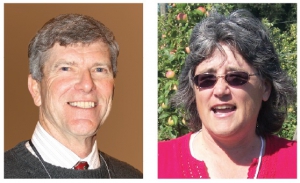
Stephen Hoying, left, and Alison DeMarree, right.
The Cornell University team that built the tall spindle apple orchard system lost two members in July, as Stephen Hoying and Alison DeMarree retired.
They both joined Cornell in the same year, 1982, as extension educators in the Lake Ontario Fruit Program serving growers in western New York.
They became key figures in the development of the tall spindle system, which was developed under the leadership of Dr. Terence Robinson, who came to Cornell in 1984.
DeMarree’s specialty was production economics and business management, and she did the analytical work demonstrating the profitability of the tall spindle system.
Hoying was the cultural practices leader on the team. “I was kind of the field guy,” Hoying said. “I collected data and arranged locations for field research. I found growers willing to cooperate with us and take care of the trees. Growers made large plantings, two to three acres each, so we had real-world conditions.
“It was perfect for me,” Hoying said. “I could do extension work and do applied research as well.”
The tall spindle system won converts fairly quickly, as the best growers who tested the system were eager to increase plantings, and other growers were convinced of the system’s value. Tall spindle is now being widely adopted across apple-growing country and is being adapted for pears and cherries.
Besides working with Robinson on tall spindle systems and rootstocks, Hoying worked with Dr. Alan Lakso on growth regulators and with Dr. Bob Andersen on stone fruit culture. Both have since retired. Hoying was a leader for programs in cultural practices that included fruit variety selection and testing, rootstocks, irrigation, fertilization, ground cover management, crop management, growth regulator usage, thinning, vigor control, and others.
“I also served as local resident expert for programs and information outside my subject matter with responsibilities including pest management, production economics, labor, harvest maturity, and postharvest storage and handling,” he said. “That’s the nature of extension—knowing a little about a lot of things.”
Over the years, Hoying became well known to growers in other states, too, speaking frequently at winter horticulture meetings in Pennsylvania, Michigan, California, Washington, and other states, and at International Fruit Tree Association conferences. He spoke on topics as varied as tree planting, trellis construction, renewal pruning, and crop load management.
In 2006, as part of a reorganization of Cornell’s staffing, Hoying moved to Highland, in eastern New York, the heart of another fruit production region in the Hudson River Valley. There he worked with plant pathologist Dr. Dave Rosenberger and entomology extension specialist Peter Jentsch. Rosenberger retired last year, and Jentsch took over as superintendent of the lab.
The Hudson Valley Lab, which Cornell has considered for closure, has been rejuvenated with an influx of grower support—a minimum of $100,000 a year for at least three years. A new extension fruit specialist, Dan Donahue, has replaced Mike Fargione, who resigned last year.
Hoying came to Cornell from the University of California at Berkeley, where he was a research associate in entomology for Helmut Riedl’s tree fruit insect program.
Raised on a field crop farm in Ohio, Hoying received his bachelor’s in zoology and master’s degree in entomology from Michigan State University and did graduate studies at University of California, Davis, but left before finishing a doctorate.
Economics
DeMarree and her husband, Tom, operate a fruit farm in Williamson, New York, where they practice what she preaches in her extension economics work. They manage 180 acres of fruit in tall spindle apple plantings and V peach systems and are working to mechanize pruning, tree training, and thinning using platforms. Last year they bought a Wafler apple harvester.
She also uses the farm to maintain a large planting of new and potentially new apple varieties being developed at Cornell by Dr. Susan Brown, evaluating their performance in the orchards and consumer acceptance at farm markets.
One project she worked on for years followed western New York growers, analyzing their businesses and determining cost of production, investment, and profitability. She covered all the fruit and berry crops.
In her work on labor and business management, DeMarree helped growers with recordkeeping systems to meet labor laws and regulations; covered all aspects of labor management; did analysis of profitability for growers adopting new technologies from mating disruption to orchard platforms; and helped them with risk management using crop insurance.
She grew up in western New York, was very active in 4-H and FFA, and became a vocational agriculture teacher before getting her master’s degree at Cornell. As a woman vo-ag teacher, she said, she impressed the students with her welding skills. “I could lay down a very nice bead.” •






Leave A Comment